 What is vascular surgery?
What is vascular surgery?
Vascular surgery is used to treat problems with your blood vessels, including arteries, veins and lymphatic vessels. Vascular surgery is for people with vascular diseases that can’t be treated by less invasive, nonsurgical treatments. It’s performed for conditions such as aneurysms and embolisms.
Vascular surgery may involve endovascular procedures in which catheters (thin, flexible tubes) or stents (mesh-like tubes) are inserted to maintain open arteries or veins.
Vascular surgery is also used to redirect blood vessels in people with poor circulation and to help prevent strokes.
What conditions can be treated with vascular surgery?
Vascular surgery may be performed for people with vascular diseases. Some of these conditions can become life-threatening if left untreated. Your vascular disease symptoms will be dependent on the specific condition. Conditions include:
- Aortic aneurysms occur due to a bulging of the aorta, the largest artery in your body.
- Atherosclerosis is a thickening or hardening of the arteries, which can lead to coronary heart disease if not treated with balloon angioplasty and/or stenting to open the blocked arteries.
- Blood clots are a condition that can be treated with thrombolytic therapy, or thrombolysis, which breaks up the clots.
- Carotid artery disease is marked by a buildup of plaque in the arteries in your neck, which can lead to reduced blood flow to the brain and, eventually, stroke.
- Heart failure can be treated with vascular surgery.
- Peripheral artery disease, sometimes called peripheral vascular disease, is a condition that narrows the arteries and reduces blood flow to the limbs, especially legs.
- Thoracic outlet syndrome is a compression of nerves and blood vessels at the shoulder.
- Varicose veins (disease of veins) are swollen veins, which can eventually lead to more serious conditions, such as venous stasis or deep vein thrombosis.
Why choose Ohio State for vascular surgery?
Vascular surgeons at The Ohio State University Wexner Medical Center have expertise in treating all of the conditions that make vascular surgery necessary. We are also skilled in treating them with medication, before moving to a surgical solution.
We have extensive experience with minimally invasive procedures, including coronary angioplasty and stenting -- a peripheral artery disease treatment; stent grafting or endovascular repair for treating aneurysms; and carotid stenting. We also are experts at open surgical repair for cases where minimally invasive treatments aren't possible.
What to expect during vascular surgery?
Your physician may do an evaluation of all organ systems including the heart, lungs, circulatory system, kidneys and the gastrointestinal area. The decision whether to have surgery or not is based on the outcome of these evaluations.
Prior to your vascular surgery, you’ll meet with your surgeon to discuss your medical history, the medicines you take and any questions you have about your procedure.
During your procedure
Depending on your condition, the Ohio State Wexner Medical Center offers minimally invasive procedures, endovascular procedures and standard open procedures.
After your procedure
Recovery time in intensive care and the hospital varies with each surgery and depends on a variety of factors. Like any part of your body that has been injured, your surgical site needs time to rest and mend itself.
Your physician or vascular surgeon will give you the special instructions you need to follow after your surgery. Cardiac rehabilitation may also be required.
How would you like to schedule?
Don’t have MyChart? Create an account
